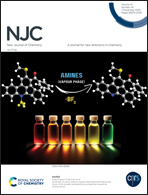LIS-doped thin-film nanocomposite membrane adsorbent with low shielding effect for effective lithium recovery from geothermal water†
Abstract
Membrane adsorbents made from lithium-ion sieves (LIS) have gained a lot of attention for lithium recovery from geothermal water. Compared with powdery LIS, the membrane adsorbent suffered a severe decline in lithium adsorption efficiency and poor structural stability, making it difficult for use in industrial applications. Here, a novel thin-film nanocomposite (TFN) membrane adsorbent was constructed by incorporating LIS into polyamide film by an interfacial polymerization approach. Accompanied by the membrane-forming process, the LIS achieved in situ functional modification by the synergistic manipulation of dopamine and piperazine and anchored on the surface of the TFN membrane, causing a low shielding effect on LIS, high interfacial compatibility and structural stability. Applied in natural geothermal water at 328.15 K, the well-designed TFN membrane adsorbent exhibited an uncompromising Li+ adsorption capacity of 23.94 mg g−1, and reached equilibrium adsorption in a shorter time of 35 minutes than powdery LIS (QLi = 25.80 mg g−1, t = 45 minutes), even after undergoing a fifth cyclic adsorption–desorption process. The calculated thermodynamic parameters of ΔH°, ΔS° and ΔG° during the Li+ adsorption process indicated its nature of an exothermic and spontaneous process. The structural advantages of the TFN membrane adsorbent shed light on its potential application in lithium recovery from geothermal water.



 Please wait while we load your content...
Please wait while we load your content...